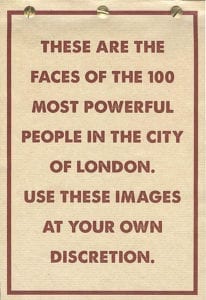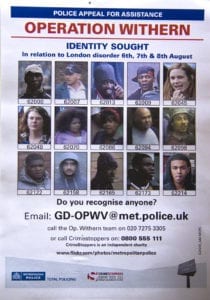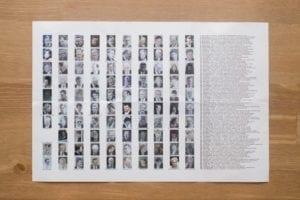“In the past, no government had the power to keep its citizens under constant surveillance,” wrote George Orwell in his novel 1984. But where his work depicts an imaginary dystopian society, a version of the mass surveillance it describes is now an everyday reality in the West. Civil liberties, some contend, are being traded for security.
That’s the debate Spanish photographer Daniel Mayrit engages with in You Haven’t Seen Their Faces, a seminal work which won the Paris Photo-Aperture Foundation First PhotoBook Award in November 2015. The book is a bizarre collection of CCTV-style, strongly pixellated and blown-up portraits of “The 100 most powerful people in the City of London”, coarsely printed on Kraft paper and bound together with three gold-coloured screws.

Every image is tagged with hand-written notes and a caption, giving the same information about each subject – full name, position, company, reported net worth and/or salary. The basic data that goes with the picture of Christian Levett, for example, reads “Founder. Clive Capital. £13m salary. Net worth £250m”, presented in a font that suggests officialdom. The hand-written overlay adds: “Art collector. Founder MACM museum worth £75m. World’s biggest commodities hedge fund. £13m payout to CEOs when bank had losses.”
“The people featured here represent a sector which is arguably regarded in the collective perception as highly responsible for the current economic situation,” says the author. “But nevertheless they still live in a comfortable anonymity.”
You Haven’t Seen Their Faces is Mayrit’s response to the handouts distributed by London’s Metropolitan Police after the 2011 riots, which showed photographs of alleged participants taken from CCTV footage. Mayrit comes from the traditional working- class area of Vallecas in Madrid, but from 2008-2013 lived in Tottenham, north London – the epicentre of the 2011 disturbances.
“I lived around 500 yards from the place where Mark Duggan was shot by the police,” he says. “When the ensuing riots spread, the media focused on the rioting but never addressed the causes. The police distributed photos of suspects in our mailboxes and the format resembled ‘Wanted’ posters. The presumption of guilt was there.”

For Mayrit, the riots had to be understood against a backdrop of financial and political corruption, and, as he made his photobook, a number of major scandals came to light. “The Lux Leaks, the affairs concerning HSBC, the manipulation of the Libor index and others – in these cases, it was as if those acts couldn’t be directly attributed to specific people,” he says. “Meanwhile, some people were being arrested for stealing a pair of trainers.”
He decided to “fill a void in representation” and, to his surprise, found “there wasn’t a more extensive coverage of the economic crisis”. The project took him three years to complete, while he was studying photography at the University of Westminster, and the first time it was exhibited, in June 2014 at PhotoEspaña, it was picked up by publisher Verónica Fieiras, co-founder with Ilkin Huseynov of Riot Books.
“At first, I refused her proposal because I considered our lines of work to be too different,” Mayrit says. As he talked with Fieiras, though, he started to see how the partnership could work, and he says her input was essential in creating the final version. “She helped me realise how bad my initial phonebook dummy was,” he explains. “It was absolutely conventional – Vero reeled me in little by little.”
It took the pair eight months to come up with the concept for the final photobook, and Fieiras was instrumental in making it – going to a nondescript copyshop to reproduce the pages, carrying the copies in suitcases and physically putting it all together. “Initially, I was bundling each set of copies and putting in the screws myself,” she says. “My fingers ended up bleeding.”
Each image underwent a different treatment, meaning there could be no colour profile management or even uniform colour correction. “It was a back and forth bargaining process,” says Fieiras. “From the first moment I had a clear thought: it had to be shiny paper – something disgusting, ugly. Dani wanted to preserve the aesthetics of his images, whereas I was looking for the opposite effect.”
Mayrit realised she had a point, and that using “the worst possible paper and the worst possible technique” would deprive the images “of any glamour, from a conceptual point of view”. The pair also very deliberately defaced the images – writing on them, punching holes through them and even adding the occasional Post-it note.
“The political poster, in particular the anarchist poster, was a source of inspiration for me,” says Mayrit. “You could actually unscrew the book and post the images on the streets if you so wished.”

Fieiras says the book is meant to be “a wake-up call; something that would upset the reader”; Gerry Badger, who has already committed to including it in his forthcoming compilation on protest-themed photobooks (which will be published by Contrasto), describes it as “a clever protest book” that “asks some relevant and uncomfortable questions about our world today”.
It is an analysis that Mayrit will be happy with. “There is an obvious bias that we decided to incorporate in the pictures,” he says. “One that doesn’t necessarily imply any sort of wrongdoing but which leaves it up to the reader to ask those kinds of questions.”
Using video surveillance – as the Met Police does – doesn’t make for a candid representation, he contests; instead it evokes a sort of panopticon, the realisation that there is always some entity watching us. With his work, he hopes to “turn the camera the other way round, against power”.
If that makes the project sound political, Mayrit is even more so. He is actively involved with the cultural office for Podemos, Spain’s radical new party, and cites Nobel Prize-winning “modern liberal” economist Paul Krugman as an influence, as well as political journalist Matt Taibbi. “It may be possible that everything around us is crap,” Mayrit says, referencing the economic crisis and the wave of corruption scandals that have rocked contemporary Spain. “But we can’t deny this: we are living in very interesting times.”
Given this background, he was surprised to win the Paris Photo-Aperture Foundation award – especially as Paris Photo is sponsored by investment bank JP Morgan. But he sees his award as proof that “there is still a place for criticism within the institutions”, and he hopes it will encourage other photographers to make politically motivated work and give “more visibility to a critical line”. “Not everything is about aesthetics,” he says.
You Haven’t Seen Their Faces by Daniel Mayrit is published by Riot Books; Mayrit has made the PDF of the book freely available via Chaco Books. Mayrit’s new book, Authorised Images, is published by PHREE.
